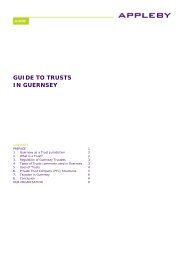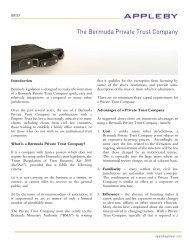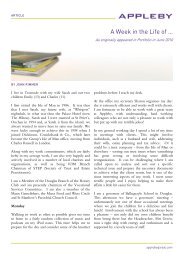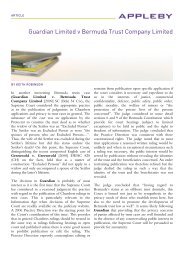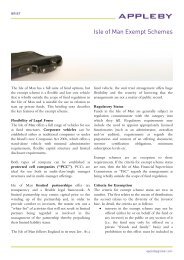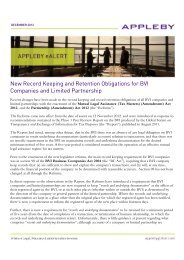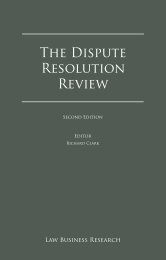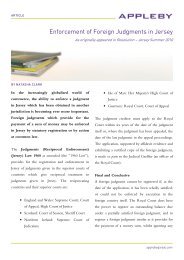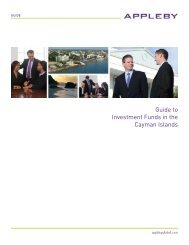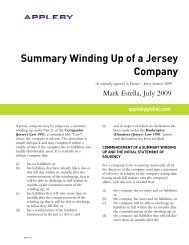FIA Leveraged Fund: The Cayman Court Takes a Strict ... - Appleby
FIA Leveraged Fund: The Cayman Court Takes a Strict ... - Appleby
FIA Leveraged Fund: The Cayman Court Takes a Strict ... - Appleby
Create successful ePaper yourself
Turn your PDF publications into a flip-book with our unique Google optimized e-Paper software.
APRIL 2013<strong>FIA</strong> <strong>Leveraged</strong> <strong>Fund</strong>: <strong>The</strong> <strong>Cayman</strong> <strong>Court</strong> <strong>Takes</strong> a <strong>Strict</strong>Approach to Distributions in Kind<strong>The</strong> <strong>Cayman</strong> Islands <strong>Court</strong> of Appeal has recently handed down its written reasons for dismissing the <strong>FIA</strong><strong>Leveraged</strong> <strong>Fund</strong>’s appeal from a judgment of the Grand <strong>Court</strong> which ordered that the <strong>Fund</strong> be wound upon the petition of three redeeming investors whose redemption requests had purportedly been met bydistributions in kind. Although the decision turned on the specific facts of the case, the <strong>Court</strong>’s judgmentemphasises once again the primacy of the investment agreement between the fund and its investors, aswell as the importance of valuation and timing issues when a fund is considering paying out a redeeminginvestor other than in cash.<strong>The</strong> BackgroundIn April 2012 the Grand <strong>Court</strong> heard the winding-up petition in respect of the <strong>FIA</strong> <strong>Leveraged</strong> <strong>Fund</strong> (the“<strong>Fund</strong>”) which had been presented by three creditors, which were US public employee pension Plans. <strong>The</strong>fund was a typical Master/Feeder structure, comprised of the <strong>Fund</strong> as feeder and another <strong>Cayman</strong>exempted limited company as the Master <strong>Fund</strong>. <strong>The</strong> <strong>Fund</strong> and Master <strong>Fund</strong> were managed by aninvestment manager in Bermuda and were members of the wider Fletcher funds group. <strong>The</strong> terms of theseries of shares of the <strong>Fund</strong> into which the Plans had made their investments as to redemption providedthat shares were redeemable at the end of each calendar month on sixty days’ prior written notice andthat 90% of the redemption amount was payable with a true-up of the balance when the <strong>Fund</strong> had finallydetermined the redemption price of each share. Also, and in respect of this series of shares, a supplementto the offering memorandum provided that the <strong>Fund</strong> was obliged to pay 90% of the redemption amount incash or in kind within 15 calendar days of the redemption date, with up to 10% being retained until nolater than 30 days after the completion of the <strong>Fund</strong>’s audit for the year in which the redemption amountwas payable.<strong>The</strong> first petitioner, FRS, made two redemption requests for separate amounts, first on 14 March 2011 andthe second (in respect of the balance of its shares) at the end of June that year. MERS, the secondpetitioner, made a redemption request first on 3 March 2011 and a second such request, again seeking toredeem the balance of its investment in the <strong>Fund</strong>, on 22 June. Finally, the third petitioner, NOFF, made aredemption request on 27 June 2011 in respect of all of its shares.In response to these requests, the <strong>Fund</strong> distributed promissory notes (which had been issued to it by theMaster <strong>Fund</strong>) to FRS and MERS on 15 June in purported satisfaction of their first redemption requests. <strong>The</strong>notes were rejected by each investor, which alleged that they did not discharge the debt which was owedto them by the <strong>Fund</strong>. <strong>The</strong>re then followed a series of extensions of time for the <strong>Fund</strong>, but the <strong>Fund</strong> was
unable to make payment by the final agreed extension of 15 December 2011. <strong>The</strong> Plans thereforepresented the winding-up petition at the end of January 2012, alleging that no payment had been made tothem in satisfaction of their outstanding redemption requests. <strong>The</strong> petitioners also alleged that it was justand equitable that the <strong>Fund</strong> should be wound up for reasons which it was not necessary for the <strong>Court</strong> ofAppeal to consider and which will not be considered further here.In defence of the petition the <strong>Fund</strong> contended that it had in fact paid the amounts due to the Plans by wayof distributions in kind, comprising, first, the promissory notes and assignments, and secondly, the issueon 13 February 2012 (some two weeks after the presentation of the petition) to the Plans of shares in anew special purpose vehicle (“SPV”), which held investments formerly held by affiliates of the Master <strong>Fund</strong>and which had been created for the purpose of acting as a vehicle to facilitate a distribution in kind to thePlans. <strong>The</strong> mechanics of the transaction by which the redemptions in kind were purportedly made were setout by the director of the <strong>Fund</strong> in his evidence opposing the petition. As he explained, the Master <strong>Fund</strong> didnot in fact make direct investments itself but invested in other funds in the same Fletcher group of funds,which then invested in other funds in that group, and these affiliates had contributed assets which theyheld to the SPV in order to ensure that the assets held by the SPV were sufficient to satisfy the balanceowed to the Plans by the <strong>Fund</strong>. <strong>The</strong> relevant resolutions of the Master <strong>Fund</strong> and the <strong>Fund</strong> were producedin evidence and showed the chain of decisions pursuant to which the directors of the funds transferredcertain underlying assets of one fund in the Fletcher group into the SPV, ascribed a value to those assets,and a resolution of the <strong>Fund</strong> that the transfer of shares was to effected to satisfy in kind 90.15% of thevalue of the petitioners’ redemption requests.<strong>The</strong> assets transferred to the SPV, the shares of which were issued to the Plans, were examined duringthe trial of the petition. <strong>The</strong>y comprised a right – acquired by one of the Fletcher group funds – to investUS$65 million in the series C convertible preference shares of a publicly traded US bank (“UCBI”). <strong>The</strong>right to invest carried with it a potential perpetual right to income which might be called by UCBI 5 yearsfrom the date of the investment which, if called, would be converted to a right to common stock and afurther US$35m of warrants in the common stock in UCBI. However, in the period since the right wasacquired UCBI had announced a reverse stock split under which each 5 preferred shares in UCBI would becancelled and replaced with one share. That led to uncertainty as to just what the right comprised anduncertainty as to its value, although the directors of the <strong>Fund</strong> had adopted the higher of the possiblevalues when valuing the asset for the purposes of the transaction.<strong>The</strong> Judgment<strong>The</strong>re were two questions for the <strong>Court</strong> of Appeal to decide on the appeal. <strong>The</strong> first was whether the <strong>Fund</strong>was entitled to make a distribution of the shares in the SPV to the Plans in order to redeem the Plans’investments in kind. If the answer to the first question was yes, the second question was whether thedirectors had properly exercised their discretion in adopting the higher valuation of the asset held by theSPV when valuing the SPV for the purposes of the redemption.In relation to the first question, the <strong>Court</strong> of Appeal held that the answer to it depended on theconstruction of the investment agreement (comprised by the articles of association of the <strong>Fund</strong> and therelevant offering documents) between the <strong>Fund</strong> and its investors. <strong>The</strong> <strong>Court</strong> noted that clause 11F of thearticles of association provided that:“Subject to the next paragraph of this article, amounts due on redemption for participating sharesredeemed will be sent … as follows: At least 90% of the amount estimated by the directors to bedue on redemption shall be paid by the company generally within 35 days of the date that theshares were redeemed and the remaining amount shall be paid when the company has finallydetermined the redemption price for the participating share. If the initial payment made by thecompany exceeds the finally determined redemption amount, that holder shall repay to thecompany on demand the amount of any such excess.
With respect to series N shares, the company will pay at least 90% of the redeemed amounts incash or in kind without interest within 15 days of the date that the shares were redeemed and thecompany, subject to the discretion of the directors, will retain up to 10% of such redemption untilno later than 30 days after the completion of the audit of the financial statements relating to thefiscal year of the company in which the redemption occurred.”This was supplemented by a clause in the offering documents which stated:“An investment in the fund provides limited liquidity since the shares are not freely transferableand investors generally may redeem their shares only at the end of a calendar week. <strong>The</strong>re can beno [assurance] that the fund will have sufficient cash to satisfy redemption requests or that it willbe open to liquidate investments at the time of such redemption request at favourable prices.Under the foregoing circumstances and under other circumstances deemed appropriate by theboard of directors, investors may receive in kind distributions from the fund's portfolio. Suchinvestments so distributed will not be readily marketable or saleable and may have to be held bysuch investors for an indefinite period of time. As a result, the investment is suitable only forsophisticated investors.”By reference to these provisions, and provisions in the offering documents which contained provisions thatwere nearly identical to the second part of clause 11F quoted above, the <strong>Court</strong> of Appeal held that “theintention is that, if an investor seeks to redeem at a time when the <strong>Fund</strong> is illiquid, his request can besatisfied by transferring to him an asset which is held in the <strong>Fund</strong> and is available for distribution.” As at15 September 2011, that being the date on which the Plans were entitled to be paid (that date being 15days after the right to be paid out crystallized) the assets which were distributed to the Plans were notassets belonging to the <strong>Fund</strong>; in fact they did not exist at all because the SPV had not been incorporatedas at that date.Having decided that the distribution in kind was not a valid distribution under the terms of the investmentagreement, it followed that the Plans were creditors of the <strong>Fund</strong> which had not been paid and that theGrand <strong>Court</strong> was right to have ordered the winding up of the <strong>Fund</strong>.In light of that, it was not strictly necessary for the <strong>Court</strong> of Appeal to decide the second question, but itwent on to consider the point in the event that its answer to the first question was incorrect. <strong>The</strong> secondquestion was whether the directors had properly exercised their discretion to ascribe the value which theyhad to the asset transferred to the SPV. As mentioned above, there was uncertainty about what the rightentitled the holder to receive, which lead to two widely different valuations, the higher of which thedirectors had adopted for the purposes of the redemption in kind.<strong>The</strong> <strong>Court</strong> of Appeal held, first, that there was no evidence that the directors of the <strong>Fund</strong> actually appliedtheir minds to the question of value as at the time the transfer of the asset to the SPV was effected. <strong>The</strong>directors simply adopted an internal valuation which had been arrived at by parties within the Fletcherfunds group. Secondly, the only formal valuation that was before the <strong>Court</strong> was dated two weeks followingthe purported in kind distribution. Thirdly, there was a subsequent report that showed the very greatvariance in the value of the asset, depending on the view one took of the UCBI reverse share split, but noevidence that the directors had taken that issue into account when arriving at their valuation, such thattheir exercise of discretion could not be said to have been rational. And fourthly, it was no answer for thedirectors to say, in relation to the third issue, that they had a complete discretion in ascribing the valuewhich they did to the asset – in this context the <strong>Court</strong> of Appeal applied the English <strong>Court</strong> of Appeal’sdecision in Zuckerman International Bank v Standard Bank (London) Limited (2008), in which it had beenheld that “a decision maker’s discretion in circumstances of this nature is limited as a matter of necessaryimplication by concepts of honesty, good faith and genuineness and a need for the absence ofarbitrariness, capriciousness, perversity and irrationality”.
DiscussionAs noted at the outset, this decision turns on the specific terms of the investment agreement which thePlans made with the <strong>Fund</strong> when they made their investment and the somewhat peculiar factualcircumstances of the case. <strong>The</strong> terms which were scrutinized by the <strong>Court</strong> are however fairly standard inthe market and the decision will therefore be of wider interest.<strong>The</strong>re are also interesting questions raised by the judgment. <strong>The</strong> first question is whether the <strong>Court</strong> wasright to decide what it did in relation to the distribution in kind issue. <strong>The</strong> <strong>Court</strong> of Appeal held that theredemption in kind was invalid because the shares in the SPV, rather than the asset which was transferredto the SPV, did not exist and were not therefore part of the <strong>Fund</strong>’s portfolio as at the date when the Planswere entitled to be paid (i.e. 15 days after the redemption date). But does that actually matter? If aperson is owed the proceeds of redemption, and the debtor is entitled to make a payment in kind, whatdoes it matter if the asset does not come into the debtor’s possession until after the date for payment haspassed as long as the asset is of a value equal to the debt? What the <strong>Court</strong> of Appeal has effectively doneis read the provisions together in order to hold that the right to redeem in kind may only be exercisedwithin the time limited for doing so by using assets from within the <strong>Fund</strong>’s portfolio at that date. That is astrict construction of the right to redeem in kind, but it is the right one because it is the one which is mostconsistent with the intentions of the parties when they entered into the investment agreement.Assume, however, a slightly different factual scenario, where the <strong>Fund</strong> already owned an SPV at the timethe redemption in kind was due for payment and was therefore able to accept the transfer of assets froman affiliated entity into this SPV after the date for payment had passed. Would that have been valid underthe terms of the investment agreement? Or this scenario, where the <strong>Fund</strong> owned assets at the time whenthe redemption requests fell due which could only be transferred by hiving them into an SPV and issuingshares in the SPV to redeemers, but there was a delay in creating the SPV into which the assets were tobe transferred. Would the <strong>Court</strong> have still held that the assets did not exist as at the relevant date, orwould the <strong>Court</strong> have taken a different approach?<strong>The</strong> judgment suggests that the answer to the first of these further questions ought to be yes, since theassets (the shares) would have been within the <strong>Fund</strong>’s portfolio at the time when the payment in kind wasdue. However, the possibility should not be discounted that in such a case the <strong>Court</strong> might well seek tolook through the SPV to see whether the assets which were transferred into the SPV were within theportfolio at the relevant time. <strong>The</strong> language of the relevant provision of the agreement relied upon by the<strong>Court</strong> of Appeal is broad enough to permit the <strong>Court</strong> to adopt such an approach, particularly if thatapproach is one which avoids the investor suffering a substantial loss immediately upon being paid in kindin circumstances where it appears that the <strong>Fund</strong> has acted arbitrarily or selected assets of uncertain valuefor distribution. Such approach is also consistent with the traditional creditor-friendly approach of the<strong>Cayman</strong> court.<strong>The</strong> answer to the second question, applying the strict approach adopted by the <strong>Court</strong> of Appeal, wouldappear to be no: although the assets themselves do in fact exist within the <strong>Fund</strong>’s portfolio, a failure totransfer them into the SPV in time appears to invalidate the distribution.That may be an unfortunate and unintended consequence of the judgment, and may also suggest that the<strong>Court</strong>’s focus on the time of the SPV’s creation was a somewhat artificial means of achieving the rightoutcome in this particular case; the judgment should not perhaps be regarded as establishing a principleof general application in this regard. Nevertheless, a fund wishing to ensure that its redemptions in kindfall squarely within the bounds of the <strong>Court</strong> of Appeal’s decision may be well advised to keep a few SPVson hand for that purpose.
In respect of valuation issues, while this part of the <strong>Court</strong> of Appeal’s decision was strictly obiter, it servesas a useful reminder to fund directors that their duties require them to adopt an approach which isreasonable and rational. Here it was clear to the <strong>Court</strong> that the directors had failed to do so: the decisionsto allocate the relevant assets appeared to have been made in a hurry; asset valuations which werefavourable to the <strong>Fund</strong> and detrimental to the Plans had been adopted, and such independent valuationswere not contemporaneous with the decision to allocate those assets. <strong>Fund</strong>s contemplating redemptions inkind would be well advised to ensure that, when it comes to valuing the assets they are proposing totransfer, an approach is adopted which is reasonable and appropriate to the relevant circumstances andthat the decision making process is clearly recorded. Independent valuations will not be necessary in allcases, but funds are less likely to be criticized for commissioning them than failing to do so where there isreason to doubt what the present value of the asset is.For more information, please contact:Jeremy WaltonPartner+1 345 814 2013jwalton@applebyglobal.comDavid ButlerAssociate+1 345 814 2012dbutler@applebyglobal.com
DISCLAIMERThis eAlert is published by APPLEBY and is not intended to be, nor should it be used as, a substitute forspecific legal advice on any particular transaction or set of circumstances. It does not purport to becomprehensive or to render legal advice and is only intended to provide general information for the clientsand professional contacts of <strong>Appleby</strong> as of the date hereof.<strong>Appleby</strong> (<strong>Cayman</strong>) Ltd. (the Legal Practice) is a limited liability company incorporated in the <strong>Cayman</strong>Islands and approved and recognised under the Legal Practitioners (Incorporated Practice) Regulations2006 (as amended). “Partner” is a title referring to a director, shareholder or an employee of the LegalPractice. A list of such persons can be obtained from your relationship partner.




